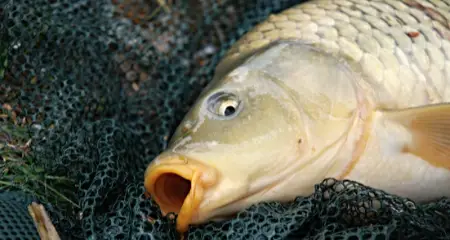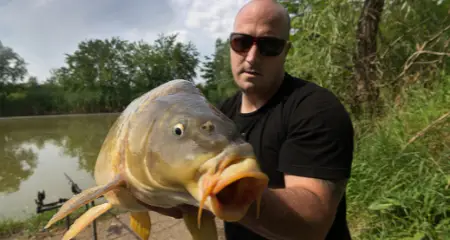Can You Eat Carp (And What Does It Taste Like)?
UPDATED 03 NOVEMBER 2023
by Robert Ceran
Originally a native fish of Asia, carp have been introduced into many European and American waters over the past century, making it one of the most common freshwater fish in the world.
And while carp are held in high esteem as fish for food in many countries, this is not the case in the United States. In fact, many Americans think of carp as unclean fish that should be avoided.
So why do carp have such a bad reputation in North America, and can you eat carp or not?

In this article we’ll discuss if carp are good to eat, what they taste like, and how you should prepare them to get the best results when eating them.
Is carp good to eat?
Yes, carp is good to eat if it’s sourced from clean water and prepared properly. It has a flaky texture and subtle flavor similar to tilapia.
However, carp flavor is strongly affected by the water quality of the environment in which it lives, and so carp is good to eat only when raised in clean water bodies.
Also, if you’re planning to cook carp, you should know that carp have big scales as well as many bones, which can make them a little challenging to prepare.
So, in order to get the best results when cooking carp, it’s also essential to clean and cook them correctly (more on that below).
To summarize, if you can get a carp raised in clean, fresh water, and if you know how to prepare it properly, you’ll find that carp is good to eat, and the meat itself is delicious.
How clean is carp meat?
Similar to many other fish species, the meat of carp is as clean as the water in which it lives.
Unfortunately, carp can live in muddy water and even tolerate a high degree of pollution, so you’ll need to make sure that you only eat carp that come from the cleanest water source.

If you eat a carp from a muddy river or polluted lake, this usually results in a strong negative aroma and smell of its meat.
In fact, many anglers say that the taste of a carp resembles the smell of the water in which it was caught.
This is something that carp have in common with other freshwater fish, such as Largemouth Bass, which can have an unpleasant flavor if they come from muddy water, but taste perfectly fine if caught in a clean lake.
Carp are bottom feeders, which means their diet consists of insect larvae, molluscs, and plants found at the bottom of lakes and rivers.
However, this diet does not mean carp are unclean, and they actually have a lower concentration of heavy metals than predatory fish, such as bass, catfish or walleye.
In general, younger carp are good to eat, while the older ones are not so tasty. This is because the younger ones have a lower concentration of environmental pollutants in their meat than the older ones.
In summary, you’ll want to eat carp that come from very clean waters, and this is something you should make sure to check before you prepare them.
What does carp taste like?
Carp meat tastes mild and flaky, and has no muddy flavor if it comes from a clean environment. It is an oily fish (similar to anchovies), and the high content of omega-3 fatty acids makes it very healthy to eat.
The high content of fish oil in carp meat results in an excellent moist, flaky texture and a great overall taste. Some people compare the taste of carp to that of salmon, though less rich.
But if you’re looking for a more intense flavor, try eating carp cooked over charcoal. This gives the flesh a smoky flavor that many people enjoy.
What are the health benefits of eating carp?
The high content of omega-3 fatty acids in carp meat makes it one of the healthiest fish to eat (if sourced from a clean environment).
This is because omega-3 fatty acids have a well documented anti-inflammatory effect, which is why they are taken in the form of supplements by many people.

In addition to this, carp meat has a relatively low content of heavy metals, since carp are omnivorous (or even herbivorous, depending on the carp species).
This is in contrast to predatory fish, such as largemouth bass or walleye, which build up more heavy metals in their meat due to the fact that they are positioned higher in the food chain.
Finally, carp meat is also rich in proteins, vitamins, and minerals, and thus provides a great source of valuable nutrients.
How can you avoid the muddy flavor of carp?
The best way to avoid the dreaded muddy flavor of carp is by eating carp from the right locations, and preparing it correctly.
The first step is to pick carp that come from a clean body of water with a healthy level of biodiversity, which you can easily check for yourself if you’re an angler.
Polluted rivers and lakes usually have a lot of telltale signs that something is wrong with them, including a bad smell when you get close to the water, foam on the surface, as well as muddy, stained water.
If you see any of these signs, don’t eat carp from that location. Also avoid carp from city canals and other urban bodies of water, and just eat carp caught in clean lakes and rivers that are regularly tested for pollution by the authorities.
Also, if you’re worried about the muddy carp taste, a great option to get rid of this is by marinating the meat in either brine or vinegar before you cook it.
Why do some people dislike eating carp?
If you ask anglers in the United States what they think about eating carp, most of them will have a negative response, and say something along the lines of carp being a rough fish, and having a muddy taste (even if they’ve never eaten one before).
So how did carp get such a bad reputation?
That’s a great question, since carp are actually regarded as a delicacy in many parts of the world, and can be found on the menu of many restaurants there.
Carp also used to be a popular source of food in the USA during the 19th Century. However, since then carp have fallen into disrepute as a food fish in North America, and many anglers are not thrilled when they catch a carp.
The reason for this issue is probably connected to the fact that carp became widely farmed in North America, which increased the carp population and made them commonly available.
This quickly gave them a reputation of being a cheap, low quality fish that is only fit as a meal for the masses, but not suitable for connoisseurs.
In addition to this, carp were often farmed in stagnant ponds, where they took on a muddy flavor from their environment, resulting in a bad taste. So, in addition to being common and cheap, this gave them the reputation of being a low quality fish for poor people.
Why are carp not highly regarded as a game fish in the US?
While carp are popular game fish throughout Europe and Asia, they are much less popular in the USA, and carp fishing is practiced by only a few anglers in American waters.
The main reason for this is because carp are considered a “poor man’s” fish, and are therefore seen as inferior to popular sportfish, such as bass and walleye.
The second reason is that carp are treated as an invasive species by many people, which is at least partially true.
Carp are the third most commonly introduced alien species on the planet, and the feeding activity of carp can disturb the delicate balance of a local ecosystem by churning up sediments and uprooting native plants, and potentially causing ecological damage.
Also, since carp often reproduce quickly and are much more robust than many native species, they tend to out-compete local game fish.
This has given them a bad reputation as a harmful invasive species. Some anglers even believe carp eat the eggs of game fish, and thereby constitute a threat to their populations.
Carp have been introduced into some canals and ditches by government agencies as part of their water management efforts aimed at reducing the growth of water plants.
Aquatic vegetation can get out of hand due to fertilizers in water drained from farmland, and it was discovered that carp can help to combat the explosion of water plants.
Grass carp are especially used in this way, since they rely almost entirely on vegetation for food.
So, since grass carp are herbivores (unlike Common Carp, which have an omnivorous diet), they can be very effective at reducing unwanted weed growth.
However, this use of carp in polluted waters has further contributed to their image as a “dirty fish” that isn’t worth treating as a valuable game fish or food fish.
What species of carp are good to eat?
In general, all species of carp are good to eat, but most fish lovers agree that the Crucian Carp (a small relative of the Common Carp and a native fish of Europe) has the best flavor.
Apart from this, the best carp species to eat are the Silver Carp, Grass Carp, and Bighead Carp.
These are herbivorous species that come from Asia, but are now commonly found in some North American lakes, reservoirs, and even several major rivers.
Finally, you can also eat Farm Carps, which are usually either Grass Carp or Common Carp, though the latter tend to have a stronger flavor than the other types of carp.
How do you clean a carp?
Now let’s talk about the right preparation of carp. As already mentioned, you need to make sure you’re using fresh carp from a clean water source in order to be confident that its meat will have a good flavor.
Also, in terms of size, it’s usually best to go for a carp that weighs around 3 or 4 pounds (while avoiding bigger individuals). In order to get the best results, you should start by cleaning off the slime, and then bleed the carp as soon as possible after catching it.
How to bleed a carp
To bleed the carp, first kill the carp with a blow to the head, and then cut out the gills.
Since the gills are the part of a carp’s body with the most active blood flow, this will result in most of the blood draining out quickly.
Alternatively, some anglers prefer to cut off the tail, and let the blood drain out that way.
During the bleeding process, it’s best to put the carp in a bucket of ice water, since this will als slow down the stress reaction that happens after you catch a carp, which can negatively affect the taste of the meat.
Once you have bled the carp, it’s time to start cleaning it. First cut off the head and the tail with a sharp knife, and then remove the entrails.
Carp scales are large and thick, making them difficult to remove, so a better option is to peel off the skin with the scales still attached.
How to skin a carp
The best way to do this is by grabbing a corner of the skin with a pair of pliers, and then pulling it off in one smooth motion.
Another advantage of doing this is that the skin adds a fishy flavor to the meat if cooked together with it, which is better to avoid by removing the skin before you cook the meat.
After you remove the skin, the next step is to remove the bloodline (also called mud vein) which is a dark line that runs along the lateral line of the carp.
It’s best to remove this, since it contributes most of the fishy taste to the meat. So if you cook the meat without it, the flavor is much more subtle.
How to deal with carp bones
Underneath the bloodline you’ll probably see a few Y-bones, which are usually best to leave in, since you’ll lose a lot of meat if you try to dig them out.
Next, use a sharp knife for filleting the carp, and separate the rib meat from the bones.
If you do this correctly (and if you’re not using a dull knife), only a small amount of bones remain in the meat, and you’ll end up with juicy carp fillets that can be cooked in a variety of different ways.
How do you cook carp?
Once you have removed the carp steaks from the rib cage, gently pat them dry and lightly season them with salt, black pepper, and your choice of herbs.
Alternatively, you can also roll each fish fillet in lightly seasoned flour, thus generating a delicious batter.
The most common ways of cooking a carp fillet is by frying, baking, braising, or making a fish soup with it. If you’re planning to batter the fillets, another great option is to deep fry them.
For deep frying, it’s best to cut the meat into smaller chunks of about 2 to 3 inches, and place these in the hot oil until they turn a rich shade of golden brown.
If you choose to bake the carp, it’s important to keep the meat moist by basting it from time to time with olive oil or lemon butter. Another option is to make fish balls, which helps to get rid of the bones.
One of my favorite recipes for baking is to place bacon strips on top of the carp meat, which comes with the added advantage of not having to baste it.
Finally, another great way to avoid potential muddy flavor is to use a curry recipe, which is usually spicy enough to overpower any fishy or muddy taste.
Final remarks
This concludes our article on the topic: are carp good to eat?
To summarize: while carp have been used as a food source by humans since ancient times, their popularity has decreased over the last Century in the USA.
But in spite of their bad reputation in North America, carp are good to eat if they are harvested from clean water and prepared correctly.
In fact, if you know how to cook it, carp tastes delicious. So if you’ve never eaten it before, it’s well worth trying it out!
